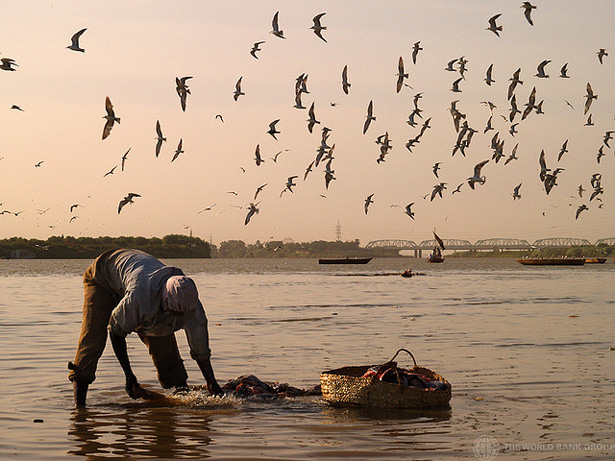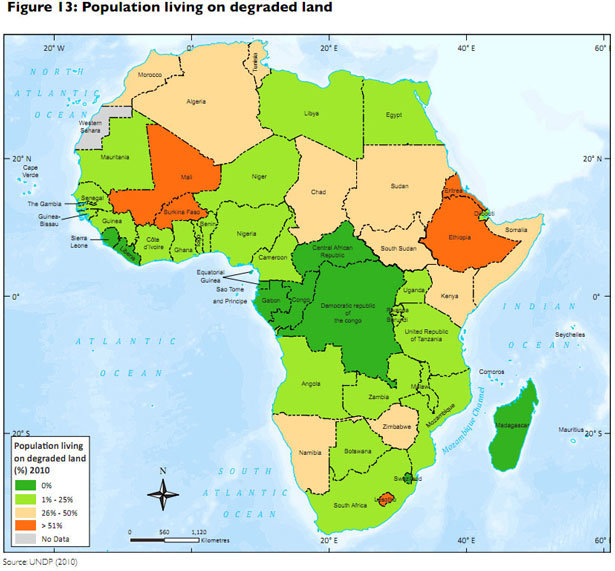-
UNEP Highlights Environmental Impacts on Health in Africa
March 20, 2013 By Carolyn Lamere
While it can be convenient to think of human health and the environment as unrelated silos, they are in fact closely related. The United Nations Environment Program (UNEP) recently released a report underscoring this point especially for Africa, where large numbers of people are directly reliant on natural resources for their livelihoods.
In the Africa Environment Outlook 3: Our Environment, Our Health, UNEP found that a full 28 percent of Africa’s disease burden is a result of environmental factors like contaminated water, which causes diarrheal disease, and air pollution, which causes respiratory illness.
The report builds off the first two Africa Environment Outlooks – the first was a general environmental survey, and the second looked at the links between the environment and development. It also serves as a guide for policymakers, identifying key interventions which target environmental risks to improve health throughout the continent.
The Biggest Threats: Mosquitos, Water, Air Pollution
The assessment goes into great detail to show the linkages between the environment and health in Africa.
 Take malaria, one of the biggest environmentally related causes of mortality on the continent. The disease thrives in warm climates and is spread as individuals are bitten by infected mosquitos. Its range has historically been fairly well defined but it’s now spreading into the cooler highlands of countries like Kenya and Rwanda which have little previous experience with it.
Take malaria, one of the biggest environmentally related causes of mortality on the continent. The disease thrives in warm climates and is spread as individuals are bitten by infected mosquitos. Its range has historically been fairly well defined but it’s now spreading into the cooler highlands of countries like Kenya and Rwanda which have little previous experience with it.The link between growing malaria prevalence and climate change is well established. Malaria is spread only by a specific type of mosquito, and only when the mosquitos live long enough to allow the parasite which causes malaria to fully mature. Warmer temperatures allow this kind of mosquito to spread and lengthen its lifespan.
The report also discusses the role of deforestation in the spread of the disease, noting that “deforestation raises sunlight, temperature, and surface water availability,” allowing mosquitoes to breed more easily.
A broader range for malaria is bad enough, but on top of that some of the efforts to curb the spread have created health problems of their own. Pesticides like DDT are used for malaria prevention in 13 countries, but such chemicals “have been implicated in a range of terminal and chronic ailments,” like cancer and reproductive health problems. Some countries, like Mauritius, spray DDT at their ports to prevent the disease from entering the country, but since the chemical is poisonous, it can destroy fragile ocean ecosystems and subsequently impact the nutrition and food security of coastal inhabitants.
The report notes that lack of access to adequate clean water, sanitation, and hygiene accounts for 10 percent of the disease burden in Africa and that many of the affected are children. Only 19 of Africa’s 54 countries are on target to meet the water and sanitation Millennium Development Goal of halving the proportion of the population without access to basic water and sanitation.
 For many African countries, the quantity of water is just as crucial as quality. Overall, Africans have access to less water than the global average (4,008 cubic meters annually vs. 6,498) and scarcity is increasing in many regions. Africa is projected to account for three out of every four people added to world population over the next century, which means more people are drawing on the same scarce resources, and urbanization clusters many of these people closer and closer together. Meanwhile, Africa is expected to bear some of the most damaging effects of climate change, including more irregular rainfall patterns.
For many African countries, the quantity of water is just as crucial as quality. Overall, Africans have access to less water than the global average (4,008 cubic meters annually vs. 6,498) and scarcity is increasing in many regions. Africa is projected to account for three out of every four people added to world population over the next century, which means more people are drawing on the same scarce resources, and urbanization clusters many of these people closer and closer together. Meanwhile, Africa is expected to bear some of the most damaging effects of climate change, including more irregular rainfall patterns.Air pollution is another common cause of morbidity and mortality in Africa. Outdoor air pollution contributes to an estimated 40,000 deaths in Africa each year, exacerbated by rapid urbanization and the poor infrastructure that often accompanies it. Indoor pollution is even more deadly. It contributes to respiratory infections which kill between 352,000 and 484,000 African children under the age of five every year. The report noted that use of solid fuels in traditional cooking stoves results in concentrations of pollutants between 10 and 30 times the safe levels defined by the World Health Organization.
UNEP notes that laws controlling outdoor pollution are unevenly enforced, but tighter controls are possible. Reducing indoor pollution, on the other hand, requires cultural and lifestyle changes, as well as investment in new technologies, like cleaner-burning stoves.
Integrated Problems Need Integrated Solutions
The report also remarks that African countries will face other significant changes apart from environmental shifts over the coming decades, from “drastic demographic shifts” to political shifts like liberalization and decentralization. At the same time, these countries will have to adjust to global changes like technological and medical advances. To continue “business as usual” is risky given these changes, says UNEP.
The report does a good job explaining the linkages between natural resource management, environmental stewardship, and human health. It even recommends some specific environmental interventions (early warning systems for extreme weather, mapping groundwater, and actively monitoring coastal areas to protect marine resources. But while UNEP discusses the general health benefits of addressing environmental challenges, it does not recommend specific health interventions to achieve those benefits, nor does it mention the benefits of an integrated approach which targets both health and the environment. Perhaps specific health sector recommendations are outside the scope of an environmental report, but they would be worth including, especially since interventions like clean cookstoves, access to reproductive healthcare, and encouragement of sustainable livelihoods directly and simply address some of the dual environment and health pressures the report describes.
Adapting to the future requires “anticipatory thinking,” says UNEP. Countries need to begin to plan for environmental changes to protect the health of their citizens. But “simply agreeing on new policy directions is obviously not a panacea for moving towards a sustainable future.” Instead, they urge policymakers to take decisive action, compile data, and engage stakeholders on environmental issues.
“The changing domestic and global situations present enormous environment and health challenges but also opportunities,” says UNEP. “Serious contemporary challenges such as climate change, biodiversity loss, land degradation, and general erosion of the natural resource base have long-term implications for human health and require policy solutions based on a far-sighted perspective.”
Sources: UN Millennium Development Goals, World Health Organization.
Photo Credit: Fisherman on the White Nile, Khartoum, Sudan, courtesy of the Arne Hoel/World Bank. Map Credit: UNEP.
 A Publication of the Stimson Center.
A Publication of the Stimson Center.





